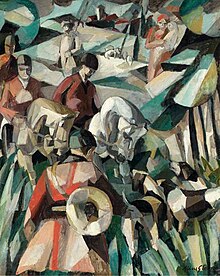
Back Grup de Puteaux Catalan Section d'Or Czech Section d'Or Danish Section d’Or German Ora Sekcio EO Grupo de Puteaux Spanish Puteaux taldea EU Groupe de Puteaux French Section d’or Hungarian Section d'Or Italian


The Section d'Or ("Golden Section"), also known as Groupe de Puteaux or Puteaux Group, was a collective of painters, sculptors, poets and critics associated with Cubism and Orphism. Based in the Parisian suburbs, the group held regular meetings at the home of the Duchamp brothers in Puteaux and at the studio of Albert Gleizes in Courbevoie.[1] Active from 1911 to around 1914, members of the collective came to prominence in the wake of their controversial showing at the Salon des Indépendants in the spring of 1911. This showing by Albert Gleizes, Jean Metzinger, Robert Delaunay, Henri le Fauconnier, Fernand Léger and Marie Laurencin (at the request of Apollinaire), created a scandal that brought Cubism to the attention of the general public for the first time.
The Salon de la Section d'Or,[2] held October 1912—the largest and most important public showing of Cubist works prior to World War I—exposed Cubism to a wider audience still. After the war, with support given by the dealer Léonce Rosenberg, Cubism returned to the front line of Parisian artistic activity. Various elements of the Groupe de Puteaux would mount two more large-scale Section d'Or exhibitions, in 1920 and in 1925, with the goal of revealing the complete process of transformation and renewal that had transpired since the onset of Cubism.
The group seems to have adopted the name "Section d'Or" as both an homage to the mathematical harmony associated with Georges Seurat, and to distinguish themselves from the narrower style of Cubism developed in parallel by Pablo Picasso and Georges Braque in the Montmartre quarter of Paris. In addition, the name was to highlight that Cubism, rather than being an isolated art-form, represented the continuation of a grand tradition; indeed, the golden ratio, or golden section (French: Section d'Or), had fascinated Western intellectuals of diverse interests for at least 2,400 years.[3][4]
- ^ Le Salon de la Section d'Or, Octobre 1912, Mediation Centre Pompidou
- ^ Exhibit catalog for Salon de "La Section d'Or", 1912. Walter Pach papers, Archives of American Art, Smithsonian Institution
- ^ Jeunes Peintres ne vous frappez pas !, La Section d’Or: Numéro spécial consacré à l’Exposition de la "Section d’Or", première année, n° 1, 9 octobre 1912, pp. 1-2.
- ^ Jeunes Peintres ne vous frappez pas !, La Section d’Or: Numéro spécial consacré à l’Exposition de la "Section d’Or", première année, n° 1, 9 octobre 1912, pp. 1-7 Archived 2020-10-30 at the Wayback Machine, Bibliothèque Kandinsky